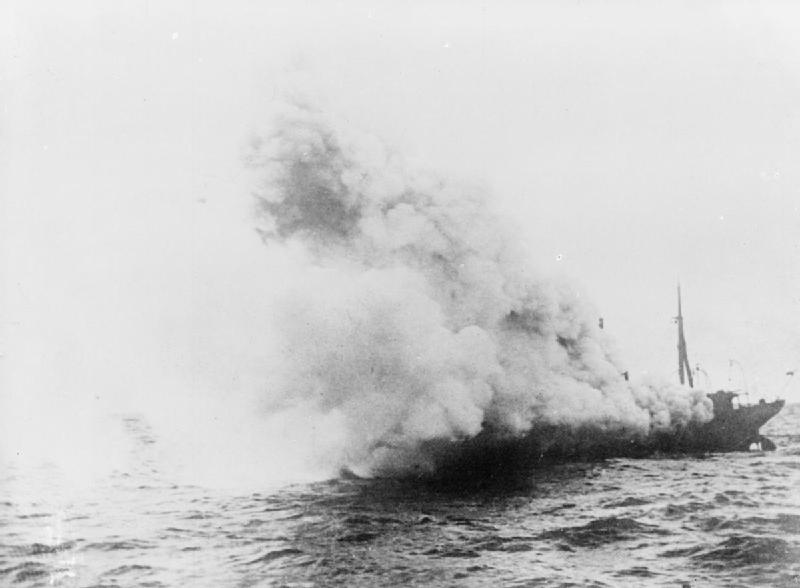SMS Meteor (1903) on:
[Wikipedia]
[Google]
[Amazon]
SMS ''Meteor'' was an auxiliary cruiser of the Imperial German Navy which operated against
 On 29 May 1915 ''Meteor'' set out on her first mission, to lay mines in the White Sea and attack Allied merchant ships engaged in taking coal and other ''materiel'' to Russia. In this she had several successes, sinking three freighters and laying her mines, which accounted for another three ships. She returned unharmed in June 1915.Halpern p33
Her second mission, in August 1915, was to lay mines in the
On 29 May 1915 ''Meteor'' set out on her first mission, to lay mines in the White Sea and attack Allied merchant ships engaged in taking coal and other ''materiel'' to Russia. In this she had several successes, sinking three freighters and laying her mines, which accounted for another three ships. She returned unharmed in June 1915.Halpern p33
Her second mission, in August 1915, was to lay mines in the
Allied
An alliance is a relationship among people, groups, or states that have joined together for mutual benefit or to achieve some common purpose, whether or not explicit agreement has been worked out among them. Members of an alliance are called ...
shipping during World War I.
Early career
Originally built as the British freighter ''Vienna'' in 1903 by Ramage & Ferguson, of Leith, for Curries shipping line. At the outbreak of war in August 1914 ''Vienna'' was at Hamburg and was seized as a prize there. To take advantage of her unmistakably British appearance, the Imperial German Navy decided to convert her into an auxiliary cruiser and minelayer. She was moved to the Kaiserliche Werft (KWW) in Wilhelmshaven, where she was equipped with two 88 mm guns and two machine guns. She had minelaying equipment installed and a capacity for 347 mines. She was renamed ''Meteor'' and commissioned in May 1915 under the command of KK Wolfram von Knorr.Service history
 On 29 May 1915 ''Meteor'' set out on her first mission, to lay mines in the White Sea and attack Allied merchant ships engaged in taking coal and other ''materiel'' to Russia. In this she had several successes, sinking three freighters and laying her mines, which accounted for another three ships. She returned unharmed in June 1915.Halpern p33
Her second mission, in August 1915, was to lay mines in the
On 29 May 1915 ''Meteor'' set out on her first mission, to lay mines in the White Sea and attack Allied merchant ships engaged in taking coal and other ''materiel'' to Russia. In this she had several successes, sinking three freighters and laying her mines, which accounted for another three ships. She returned unharmed in June 1915.Halpern p33
Her second mission, in August 1915, was to lay mines in the Moray Firth
The Moray Firth (; Scottish Gaelic: ''An Cuan Moireach'', ''Linne Mhoireibh'' or ''Caolas Mhoireibh'') is a roughly triangular inlet (or firth) of the North Sea, north and east of Inverness, which is in the Highland council area of north of Scotl ...
, but this was less successful.
In the course of this operation, while attempting to run the British blockade, ''Meteor'' was challenged by the British armed boarding vessel
Ocean boarding vessels (OBVs) were merchant ships taken over by the Royal Navy during the Second World War for the purpose of enforcing wartime blockades by intercepting and boarding foreign vessels.
Ships
See also
* Armed boarding steamer ...
HMS ''Ramsey'', which stopped her for inspection. While stopping to be boarded, ''Meteor'' was able to manoeuvre into a firing position, and, suddenly opening fire, she quickly overwhelmed ''Ramsey'', which sank.Hawkins p121
Retribution was swift, and several British cruiser
A cruiser is a type of warship. Modern cruisers are generally the largest ships in a fleet after aircraft carriers and amphibious assault ships, and can usually perform several roles.
The term "cruiser", which has been in use for several hu ...
s in the area, which had received ''Ramsey'' report, closed in on her. Notified by an Imperial German Navy airship, which was scouting in the area, ''Meteor'' captain decided to scuttle her to avoid capture. This took place on 9 August 1915. Her crew, and the survivors from ''Ramsey'', were rescued by the approaching British cruisers.
Aftermath
Though ''Meteor'' had some success, this was short-lived, and she did not survive to repeat her exploits. Also, of the eight ships sunk by her, four were neutral Scandinavian vessels, which did nothing for Germany's relations with her neighbours.Raiding career
In two voyages ''Meteor'' sank five ships, and her mines another five, with a total tonnage in excess more of 17,000 GRT.Notes
References
*Halpern, Paul (1994) ''A Naval History of World War I'' HB *Hawkins, Nigel (2002) ''The Starvation Blockades'' *Schmalenbach, Paul (1977) ''German Raiders'' {{DEFAULTSORT:Meteor (Auxiliary Cruiser) World War I commerce raiders Auxiliary cruisers of the Imperial German Navy 1903 ships Ships built in Leith Maritime incidents in 1915 Scuttled vessels of Germany World War I shipwrecks in the North Sea